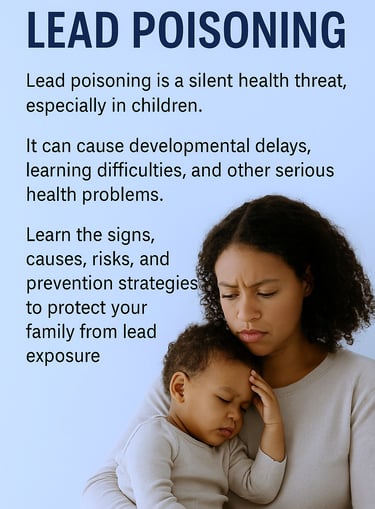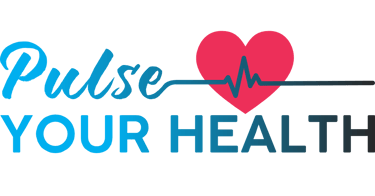Stay updated on what is trending in health. Discover tips and resources for a healthier, balanced life.
Lead Poisoning: What It Is, Why It Matters, and How to Protect Your Family
Lead poisoning is a silent health threat, especially in children. Learn the signs, causes, risks, and prevention strategies to protect your family from lead exposure.
DISEASES AND CONDITIONS
Dr. S. Ali
7/12/20256 min read


Understanding Lead Poisoning
Lead poisoning occurs when lead builds up in the body over time, often without noticeable symptoms at first. Even small amounts can cause serious health problems, particularly in children under six years old. Their growing bodies absorb lead more easily, and exposure can severely affect brain development, behavior, and learning ability. For adults, high levels of lead may cause high blood pressure, joint and muscle pain, memory problems, and even fertility issues. But the most heartbreaking effects are seen in children, whose futures can be shaped by early exposure to this hidden toxin.
Where Does Lead Exposure Come From?
Lead can be found in places many people wouldn’t suspect.
Old paint – In the US, homes built before 1978 often contain lead-based paint. As it peels or turns to dust, it contaminates surfaces and air.
Plumbing pipes – Older homes may have lead pipes or lead solder, which can leach into drinking water.
Contaminated soil – Soil near old homes, highways, or industrial sites may contain lead from past paint or gasoline use.
Consumer Products
Imported toys or jewelry –
Cheaply made toys (e.g., vinyl figurines, metal trinkets) and costume jewelry often contain lead paint or alloys. Example: 2024 recalls in the U.S. for kids’ toys exceeding 300 ppm lead.Cosmetics –
Traditional products like kohl eyeliner (surma), lipsticks (especially from unregulated brands), or hair dyes may harbor lead.
Traditional pottery and dishes – Handmade or antique ceramics with lead-based glazes can contaminate food and drinks.
Traditional Products
Folk remedies –
Some traditional medicines (e.g., Mexican azarcon or greta, Ayurvedic bhasmas, or Middle Eastern saoott) are intentionally formulated with lead. Used for ailments like upset stomachs or arthritis.Contaminated spices
Turmeric, chili powder, or saffron may be adulterated with lead-based dyes. Lead chromate adds weight and brightens color.
Workplace hazards – Jobs involving batteries, construction, or auto repair may expose workers to lead dust.
Who is most at risk?
1. Children (under 6 years old)
Hand-to-mouth behavior exposes them to lead dust or paint chips.
Developing brains and nervous systems are extremely vulnerable to lead’s toxic effects, causing lifelong learning and behavior problems.
2. Pregnant women
Lead crosses the placenta, exposing the fetus and increasing risks of miscarriage, preterm birth, or developmental harm.
Bone lead releases during pregnancy – Past lead exposure stored in bones can re-enter the bloodstream, endangering both mother and baby.
3.Older home residents
Lead-based paint peels or turns to dust, contaminating floors, windowsills, and soil.
Lead pipes or solder in plumbing can leach into drinking water, especially if corroded.
Did you know? Low-income communities often face higher risks due to aging housing and limited resources for repairs or testing.
How Lead is Absorbed
1. Ingestion (Most Common)
Swallowing lead dust or chips (e.g., from old paint, contaminated soil).
o Kids at highest risk: Hand-to-mouth behavior transfers lead from floors or toys.
Eating or drinking contaminated items:
o Lead-glazed pottery (leaches into food).
o Spices or herbs adulterated with lead (e.g., turmeric, chili powder).
o Water from lead pipes (especially if corrosive or stagnant).
o Traditional medicines (e.g., azarcon, greta).
2. Inhalation
Breathing lead dust or fumes (e.g., sanding old paint, burning lead-painted wood).
Occupational exposure (battery recycling, construction, smelting).
3. Skin Contact (Rare but Possible)
Lead-based cosmetics (e.g., kohl eyeliner) absorbed through mucous membranes.
Occupational exposure (e.g., handling lead bullets or fishing weights).
4. Placental Transfer (Pregnancy)
Lead crosses the placenta, exposing the fetus. Even low maternal levels can cause developmental harm.
Factors Increasing Absorption
Children absorb 4–5x more lead than adults (gut uptake is higher).
Empty stomachs increase absorption (lead mimics calcium or iron).
Poor nutrition (low iron or calcium diets make the body absorb more lead).
Did You Know?
Lead substitutes for calcium in bones, where it can linger for decades, releasing during pregnancy or osteoporosis.
Action Step: Reduce exposure + boost iron or calcium or vitamin C intake to block absorption.
Lead Poisoning Symptoms: Silent but Serious
Lead poisoning is a stealthy threat—it often causes no obvious symptoms until significant harm has already occurred. Unlike illnesses with clear warning signs, lead exposure creeps in unnoticed, especially in children, whose developing brains and bodies are most vulnerable. Early symptoms, like fatigue, irritability, or stomach aches, are easily mistaken for common ailments. By the time more severe effects appear (learning delays, nerve damage, or organ dysfunction), the damage may be permanent. This is why testing is critical—don’t wait for symptoms to act.
Lead Poisoning Symptoms in Children
Some children have no obvious symptoms (many cases go unnoticed without testing)
o Lead poisoning often develops silently, with no visible signs until significant damage has occurred. Blood tests are the only reliable way to detect exposure early.
Irritability or unexplained fussiness
o Lead disrupts brain function, causing behavioral changes like increased crying, aggression, or hyperactivity in young children.
Loss of appetite or picky eating
o Lead exposure can cause nausea and stomach discomfort, making children refuse food or lose interest in eating.
Fatigue or low energy
o Lead interferes with red blood cell production, leading to anemia, which can make children unusually tired or weak.
Stomach pain, vomiting, or constipation
o Lead irritates the digestive tract, causing cramping, nausea, and irregular bowel movements. These symptoms are often mistaken for common stomach bugs.
Learning difficulties (trouble focusing, speech delays)
o Lead damages the developing brain, impairing memory, attention span, and language development. This can lead to struggles in school.
Developmental delays (slower growth, motor skill problems)
o Chronic exposure can delay milestones like walking, talking, or fine motor skills (e.g., holding a pencil).
Lead Poisoning Symptoms in Adults
Headaches or persistent migraines
o Lead exposure increases pressure in the brain and disrupts nerve function, causing frequent, severe headaches.
Memory loss or trouble concentrating
o Lead harms cognitive function, leading to "brain fog," forgetfulness, and difficulty completing tasks.
Muscle/joint pain (especially in arms or legs)
o Lead accumulates in bones and soft tissues, causing chronic pain, weakness, or tingling (early signs of nerve damage).
Mood disorders (depression, anxiety)
o Lead disrupts neurotransmitters, worsening mental health. Irritability and mood swings are common.
Severe cases: Anemia, kidney dysfunction, or nerve damage
o Very high lead levels can destroy red blood cells, cause kidney failure, or lead to permanent numbness/paralysis.
Key Point: Symptoms worsen with prolonged exposure. Blood tests are critical—don’t wait for signs to appear!
Key Warning:
Symptoms mimic common illnesses, so blood tests are critical for diagnosis.
Children under 6 are highest-risk due to brain development and hand-to-mouth behavior.
No safe lead level – even low exposure can cause long-term harm.
Action Step: If you live in an older home or suspect exposure, ask your doctor about a blood lead test. Early detection prevents irreversible damage.
How Is Lead Poisoning Diagnosed?
Blood test required – The only reliable way to confirm lead exposure.
Routine screening for kids – Pediatricians often test children (ages 1–2) during checkups, especially if they live in older homes (pre-1978) or high-risk areas.
Free testing programs – In some countries, local health departments or clinics offer no-cost lead testing.
Early detection is critical – Helps prevent permanent brain damage and developmental delays in children.
Measurement (mcg/dL) – Results show lead levels in micrograms per deciliter:
o No level is "safe" – Even low amounts can harm health.
o Action level: Intervention usually starts at ≥5 mcg/dL (CDC reference level).
Next Steps if High:
Find & remove the lead source (e.g., paint, water, dust).
Nutrition matters – Iron, calcium, and vitamin C can help reduce absorption.
Follow-up testing – Monitors progress after exposure stops.
Did you know? Adults with lead exposure risks (e.g., construction, plumbing) should also get tested.
What You Can Do to Prevent Lead Poisoning
Prevention is the most effective way to fight lead poisoning.
Test your home – Eg. In US, if your home was built before 1978, get a lead inspection (paint, pipes, soil).
Fix peeling paint – Seal or professionally remove deteriorating lead-based paint.
Dust control – Wipe floors, windowsills, and toys weekly with a damp cloth.
Handwashing – Make kids wash hands before eating and sleeping and after playing outside.
Water safety – Use cold tap water for drinking and cooking (hot water leaches more lead). Run water for 30+ seconds if unused for hours.
Avoid risky products – Be cautious with:
o Imported toys, pottery, or cosmetics
o Traditional remedies/spices (e.g., azarcon, turmeric)
Eat lead-blocking foods – Calcium (dairy, greens), iron (meat, beans), and vitamin C (citrus, peppers) reduce lead absorption.
Get blood tests – Especially for kids under 6 and adults with exposure risks (e.g., construction work).
Key Tip: No safe lead level exists – even small amounts can cause harm. Prevention is always better than treatment! Testing (blood, water, paint) is key to prevention.
Can Lead Poisoning Be Treated?
While there is no way to reverse damage already caused by lead, treatment can help reduce the level of lead in the body and prevent further exposure. In mild cases, removing the source of lead may be enough, followed by monitoring and nutritional support. In more severe cases, doctors may recommend chelation therapy, which uses medication to bind with lead so it can be excreted through the urine. Treatment is most effective when started early, which is why regular screening and awareness are so important.
Key Step: Test early, act fast, and prevent re-exposure.
Final Thoughts
Lead poisoning is preventable, but only if we know where to look and what to do. It may not make headlines every day, but for families living in older homes or areas with environmental risks, it remains a serious concern. The most powerful tool is awareness — knowing the sources, recognizing the signs, and taking steps to protect yourself and your children. With regular testing, a safe home environment, and healthy habits, lead poisoning doesn’t have to be part of your story.
Sources
1. Centers for Disease Control and Prevention (CDC) – Lead Poisoning Prevention
https://www.cdc.gov/nceh/lead/
2. World Health Organization (WHO) – Lead Poisoning and Health
https://www.who.int/news-room/fact-sheets/detail/lead-poisoning-and-health
3. U.S. Environmental Protection Agency (EPA) – Lead Information
https://www.epa.gov/lead
4. National Institute of Environmental Health Sciences (NIEHS) – Lead
https://www.niehs.nih.gov/health/topics/agents/lead/index.cfm
5. Mayo Clinic – Lead Poisoning
https://www.mayoclinic.org/diseases-conditions/lead-poisoning/
6. American Academy of Pediatrics (AAP) – Lead Exposure in Children
https://www.healthychildren.org/English/safety-prevention/all-around/Pages/Lead-Poisoning.aspx
7. National Center for Healthy Housing (NCHH)
https://nchh.org/information-and-evidence/learn-about-healthy-housing/lead/
Pulse Your Health
Empowering you to achieve your health goals.
Contact
© 2025. All rights reserved.
Disclaimer: The content on this website is for informational purposes only and is not medical advice. Always seek the advice of your physician or other suitably qualified healthcare professional for diagnosis, treatment and your health related needs.
